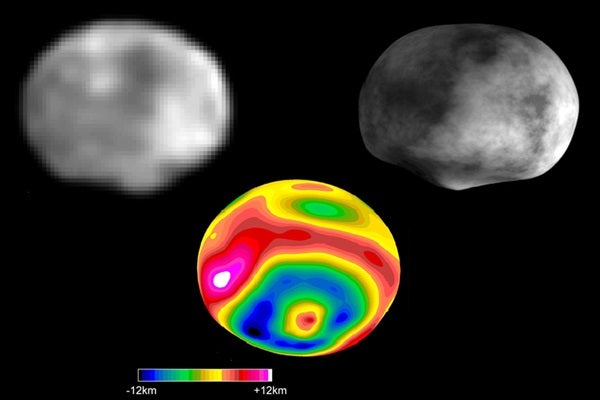The asteroid Vesta is unique. Unlike all other minor planets that orbit the Sun within the main belt between the orbits of Mars and Jupiter, Vesta has a differentiated inner structure — a crust of cooled lava covers a rocky mantle and a core made of iron and nickel – quite similar to the terrestrial planets Mercury, Venus, Earth, and Mars. Scientists, therefore, believe this onion-like-built asteroid to be a protoplanet, a relic from an early phase of planet formation more than 4.5 billion years ago. All other protoplanets either accumulated to form planets or broke apart due to violent collisions.
Vesta seems to have witnessed a huge impact, as can be seen from a large crater on its southern hemisphere. The Vestoids – a group of asteroids with a composition similar to that of Vesta – were most probably created due to this impact. Since some meteorites that were found on Earth consist of similar rock as that of Vesta’s mantle, scientists believe that this collision also hurled material from deep within the asteroid into space. But until now, there was no source in the form of near-Earth Vestoids for these meteorites with Vesta’s mantle composition.
Near-Earth asteroid 1999 AT10 fills this gap. Using the NASA IRTF, scientists were able to analyze the infrared radiation that 1999 AT10 reflected into space and compared its characteristic spectral fingerprints with those of Vesta. Apart from calcium-rich wollastonite, the measurements mainly point to iron-rich ferrosillite. “These materials can be found in Vesta’s mantle and crust,” said Andreas Nathues from MPS. “However, the ratio is decisive.” In the case of 1999 AT10, the concentration of iron is clearly lower than in any known Vestoids. “This all points to 1999 TA10 having originated from the interior of Vesta,” said Nathues.
The newly discovered body now allows important inferences about its parent asteroid. Models of Vesta’s surface based on observations made by the Hubble Space Telescope render a depth of the south pole crater of about 15 miles (25 kilometers) at the most. The new discovery now suggests that this would be the maximum possible thickness of the outer crust.
In order to reconstruct the processes that led to the formation of planets more than 4.5 billion years ago, scientists need to determine the thickness of Vesta’s layers as precisely as possible. Only this makes it possible to calculate from which material mixture the protoplanet was made, and which materials were present when the solar system formed and in what ratio.
The scientists now hope for more information about Vesta’s structure from NASA’s Dawn mission. In August 2011, the probe, which has been traveling through space since 2007, will rendezvous with Vesta and orbit the asteroid for a year. On board Dawn, there are two cameras that were designed and built under the leadership of MPS in cooperation with the German Space Agency DLR and the Institute for Datentechnik and Kommunikationsnetze of the Technical University of Braunschweig.
The asteroid Vesta is unique. Unlike all other minor planets that orbit the Sun within the main belt between the orbits of Mars and Jupiter, Vesta has a differentiated inner structure — a crust of cooled lava covers a rocky mantle and a core made of iron and nickel – quite similar to the terrestrial planets Mercury, Venus, Earth, and Mars. Scientists, therefore, believe this onion-like-built asteroid to be a protoplanet, a relic from an early phase of planet formation more than 4.5 billion years ago. All other protoplanets either accumulated to form planets or broke apart due to violent collisions.
Vesta seems to have witnessed a huge impact, as can be seen from a large crater on its southern hemisphere. The Vestoids – a group of asteroids with a composition similar to that of Vesta – were most probably created due to this impact. Since some meteorites that were found on Earth consist of similar rock as that of Vesta’s mantle, scientists believe that this collision also hurled material from deep within the asteroid into space. But until now, there was no source in the form of near-Earth Vestoids for these meteorites with Vesta’s mantle composition.
Near-Earth asteroid 1999 AT10 fills this gap. Using the NASA IRTF, scientists were able to analyze the infrared radiation that 1999 AT10 reflected into space and compared its characteristic spectral fingerprints with those of Vesta. Apart from calcium-rich wollastonite, the measurements mainly point to iron-rich ferrosillite. “These materials can be found in Vesta’s mantle and crust,” said Andreas Nathues from MPS. “However, the ratio is decisive.” In the case of 1999 AT10, the concentration of iron is clearly lower than in any known Vestoids. “This all points to 1999 TA10 having originated from the interior of Vesta,” said Nathues.
The newly discovered body now allows important inferences about its parent asteroid. Models of Vesta’s surface based on observations made by the Hubble Space Telescope render a depth of the south pole crater of about 15 miles (25 kilometers) at the most. The new discovery now suggests that this would be the maximum possible thickness of the outer crust.
In order to reconstruct the processes that led to the formation of planets more than 4.5 billion years ago, scientists need to determine the thickness of Vesta’s layers as precisely as possible. Only this makes it possible to calculate from which material mixture the protoplanet was made, and which materials were present when the solar system formed and in what ratio.
The scientists now hope for more information about Vesta’s structure from NASA’s Dawn mission. In August 2011, the probe, which has been traveling through space since 2007, will rendezvous with Vesta and orbit the asteroid for a year. On board Dawn, there are two cameras that were designed and built under the leadership of MPS in cooperation with the German Space Agency DLR and the Institute for Datentechnik and Kommunikationsnetze of the Technical University of Braunschweig.










